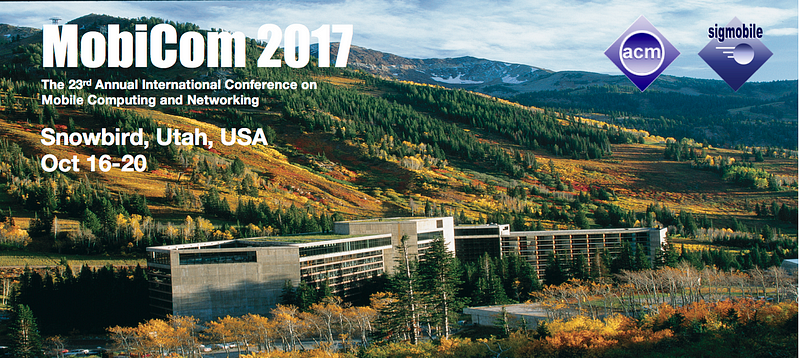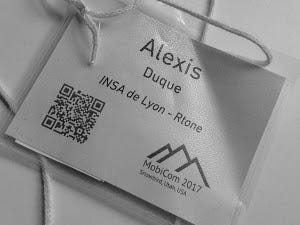ACM Mobicom'17 week
25 Oct 2017ACM MobiCom 2017 Conference

From October 16th to 20th, I attended the ACM MobiCom conference that has been held in the Snowbird Ski resort near Salt Lake City, Utah.
Sponsored since 1995 by the SIGMOBILE group of
the Association for Computing and Machinery (ACM), MobiCom is an annual
international forum that gathers researchers and students, from** academia and
industry**, to present their latest results in the fields of networks, systems,
algorithms, and applications that support mobile computers and wireless
networks.
MobiCom is a highly selective conference (about 18% of acceptance
this year) offering quality works and presentations.

The 20’ presentations were allocated along the week and peppered with social events, demos and posters sessions, concurrent workshops, the Student Research Competition (SRC) and MobiJob.

This year, during the VLCS 2017 workshop that preceded the main conference on October 16th, I presented the paper SeedLight: Hardening LED-to-Camera Communication with Random Linear Coding co-authored with Razvan Stanica, Hervé Rivano and Adrien Desportes.
During the week, some papers particularly attracted my interest:
- NICScatter : Backscatter as a Covert Channel in Mobile Devices, Z. Yang (ShanghaiTech University)
In her paper, Zhang creates a covert-channel based on the reflection of surrounding RF signals on smartphone or laptops. This is achieved controlling the impedance of the device’s wireless network interface card (NIC) by switching it ON or OFF. Even if the throughput is very low (< 2 bps) the main interest of NICScatter is that it doesn’t need any OS modification or root permissions.
- Pulsar : Towards Ubiquitous Visible Light Localization, C. Zhang and X. Zhang (University of Wisconsin-Madison)
After unveiling Litell in 2016, C. Zhang presented Pulsar, an indoor VLC localization system. Pulsar œrelies on off-the-shelf luminaries, a USB dongle with two photodiodes, and the smartphone sensors to provide accurate (about 10cm) 3D indoor positioning using the angle-of-arrival (AOA) method.
- MagneComm : Magnetometer-based Near-Field Communication, Y. Chen (Shanghai Jiao Tong University)
On the first day of the main program, Chen introduced a novel near-field communication protocol, called MagneCom, that takes advantage of Magnetic Induction (MI) signals emitted from CPUs and captured by magnetometers on mobile devices for communication.
- Battery-free Visible Light Sensing,A. Varshney, A. Soleiman, L. Mottola, and T. Voigt (Uppsala University, Sweden), VLCS ’17 Workshop best paper award
Ambush Varshney presented a Visible Light Sensing (VLS) system that consumes only tens of μWs of power to sense hand gestures and communicate. Their design uses solar cells to achieve a sub-μW power consumption for sensing and further transmit the gesture detection results by backscattering the ambient RF signals. Note that Andreas Soleiman, co-author of this paper won the Student Research Competition and showed a working prototype during the VLCS workshop demo session.
- WEBee: Physical-Layer Cross-Technology Communication via Emulation, Li, Z. and He, T. (University of Minneapolis) Best paper award
The researchers from University of Minneapolis introduced a promising approach
to physical-layer cross-technology communication (CTC) between WiFi and
Zigbee.
WEBee opens a promising direction for high-throughput CTC via
“physical-level emulation”. WEBee uses a high-speed wireless radio (e.g., WiFi
OFDM) to emulate the desired signals of a low-speed radio (e.g., ZigBee) by
manipulating only the payload of WiFi packets.
Their paper won the best
paper award.
The authors also showed WEBee during the Tuesday demo session.
Tutorial Sessions
This year, in addition to the conference and workshops, two tutorials funded by
the NSF were organised during the weekend.
These tutorials held on the
University of Utah campus, were mostly hands-on, providing exposure to emerging
wireless platforms and technologies.
The first tutorial made use of PhantomNet, a platform to enable experimental research in mobile and cellular technologies like 4G and 5G.

The second introduced the edge-computing platform created by the WiNGS Laboratory team led by Suman Banerjee (University of Wisconsin-Madison) called
Paradrop.
Paradrop provides computational and
storage capacities to the extreme edge of the network, here the WiFi Acess
Point, to avoid useless communication to a Cloud platform.


After Hawaï, Paris, New-York and Snowbird, the next edition of Mobicom will be held in New Delhi (India). I hope to be there :)